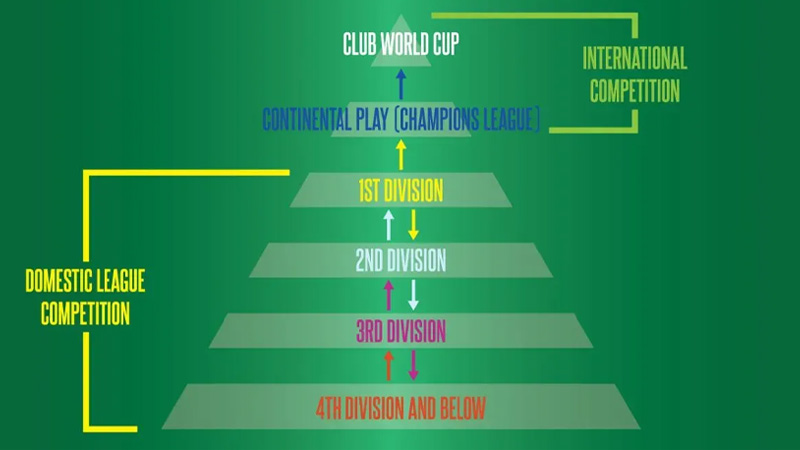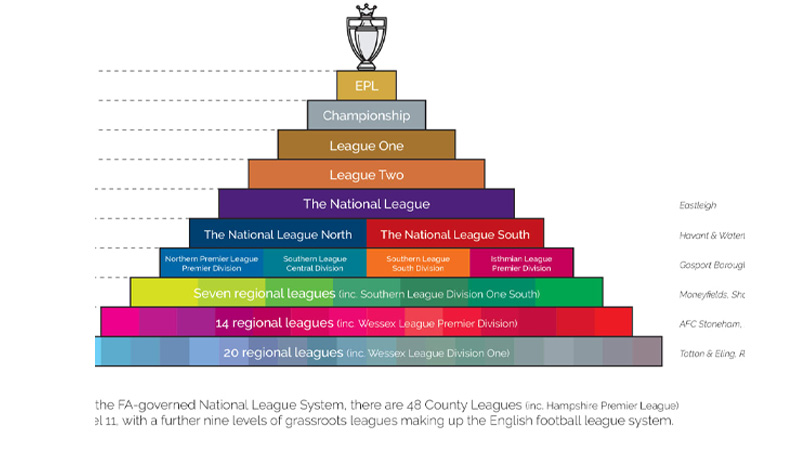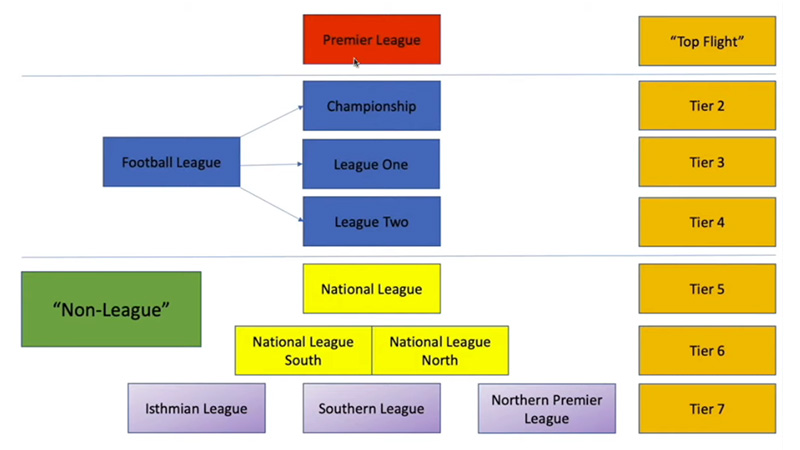Promotion and relegation in Soccer is a fundamental aspect of many football leagues worldwide, contributing to the sport’s unparalleled excitement and competitiveness.
This system provides an opportunity for teams to rise through the ranks or face the consequences of relegation based on their performance in a given season.
Clubs that excel in lower divisions earn promotion to higher tiers, while those that struggle find themselves relegated to lower divisions, creating an ever-evolving landscape of competition.
The concept of promotion and relegation has deep historical roots and has been embraced by soccer enthusiasts globally, making it an integral part of the sport’s organizational structure.
Understanding how promotion and relegation work in soccer, and the development of football talent at various levels.
What Does Promotion And Relegation Work mean In Soccer?
Promotion and relegation is a system used in Soccer (also known as football in many countries) and other sports leagues to determine which teams move up to a higher division and which teams move down to a lower division based on their performance in a given season.
This system is prevalent in many football leagues around the world and is designed to maintain competitiveness and excitement throughout the league.
Promotion
Promotion refers to the process by which the top-performing teams from a lower division are elevated to a higher division for the following season.
Typically, the team that finishes in the top position of the lower division or the top few teams, depending on the league’s structure, earns promotion.
This provides an incentive for teams in lower divisions to compete vigorously, as they have the opportunity to advance to a higher level and face tougher opponents, better exposure, and potentially more significant financial rewards.
Relegation
On the other hand, relegation is the opposite of promotion. It is the process by which the bottom-performing teams from a higher division are demoted or moved down to a lower division for the next season.
Usually, the teams finishing at the bottom of the table or in the relegation zone face relegation.
This aspect adds drama and tension to the end of the season as teams fight to avoid being relegated to a lower league, which could result in reduced revenues, fanbase, and overall prestige.
The promotion and relegation system plays a crucial role in the development and sustainability of football clubs at various levels.
It ensures that competition remains fierce throughout the league and encourages clubs to invest in their youth development and infrastructure to improve their chances of success.
This mechanism has become an integral part of the football culture and is cherished by fans for its ability to generate excitement, surprises, and underdog stories, making the sport even more captivating and unpredictable.
Where Promotion And Relegation Is, And Aren’t Used In Soccer?

Source: worldsoccertalk
Promotion and relegation are widely used in soccer leagues in various countries around the world, particularly in Europe and parts of South America.
Here are some regions where the promotion and relegation system is commonly employed:
Europe
Promotion and relegation are prevalent in European football leagues. Prominent examples include the English Premier League, where the bottom three teams are relegated to the EFL Championship, and the top two teams from the Championship are promoted to the Premier League.
Similar systems exist in other European leagues, such as La Liga in Spain, Serie A in Italy, Bundesliga in Germany, and Ligue 1 in France.
This setup allows for increased competitiveness, as clubs from lower divisions have the chance to rise through the ranks and challenge established teams.
South America
Many South American countries also utilize promotion and relegation in their soccer leagues.
Countries like Argentina and Brazil have a tiered league system with multiple divisions, where the best-performing teams are promoted to a higher division, while the worst-performing teams are relegated to a lower one.
This structure helps develop local talent, fosters strong football cultures, and sustains interest in the sport at various levels.
Other Regions
Promotion and relegation can also be found in other parts of the world, but it is less prevalent compared to Europe and South America.
Some African and Asian countries have implemented similar systems, although they might not be as widespread or established.
In North America, major professional soccer leagues like Major League Soccer (MLS) do not use promotion and relegation. Instead, they employ a franchise system, where teams are granted fixed spots in the league and do not face relegation based on their performance.
In contrast, there are regions where promotion and relegation is not commonly used in Soccer:
North America
As mentioned earlier, the promotion and relegation system is not used in major North American soccer leagues like MLS.
Instead, these leagues follow a franchise-based model, where teams have stable spots in the league regardless of their performance.
This system has been a topic of debate among fans and soccer enthusiasts, as some argue that it limits the potential for smaller clubs to rise through the ranks and achieve success at higher levels.
Australia
In the past, Australia’s domestic soccer leagues used promotion and relegation. However, since the creation of the A-League in 2004, the promotion and relegation system has been discontinued.
The A-League operates as a closed league, and clubs are not subject to relegation or promotion based on their performance.
While promotion and relegation are widely embraced in many parts of the world, their absence in some regions has sparked discussions about the best organizational structure to foster soccer development and competition in a fair and sustainable manner.
History of Promotion and Relegation in Soccer

Source: howtheyplay
The history of promotion and relegation in Soccer can
be traced back to the late 19th century when the modern form of the sport was taking shape in England.
The concept emerged as a way to regulate and organize the growing number of football clubs, ensuring competitive balance and providing an opportunity for clubs from lower divisions to progress and compete against stronger opponents.
The introduction of promotion and relegation had a profound impact on the development of football and remains an integral part of the sport’s culture today.
Early Roots
The concept of promotion and relegation in Soccer can be linked to the foundation of football leagues in England during the late 19th and early 20th centuries.
The English Football League (now known as the English Football League or EFL) was formed in 1888 and initially consisted of just two divisions, the First Division and the Second Division.
The bottom two teams of the First Division were required to apply for re-election, effectively facing a form of relegation if they performed poorly.
Growth and Expansion
As football’s popularity increased, more clubs emerged across England, leading to the need for additional divisions. The Second Division grew into multiple tiers, and the concept of promotion was introduced.
The top-performing teams from each lower division were granted promotion to the division above, creating a pathway for clubs to rise through the ranks and compete at higher levels.
Global Influence
The promotion and relegation system in Soccer quickly spread beyond England’s borders. European leagues, influenced by the English model, adopted similar structures, fostering competitive environments and stimulating interest in football across the continent.
South American countries also embraced the system, leading to the establishment of prestigious leagues with multiple divisions.
Modern Implementation
Over the years, promotion and relegation have become an integral part of soccer leagues worldwide.
Many countries have adopted tiered league systems with multiple divisions, providing a clear route for clubs to progress and decline based on their performances.
This system not only sustains competitiveness but also promotes youth development and investment in football infrastructure to achieve success at higher levels.
Challenges and Debates
While promotion and relegation have been widely accepted and cherished by fans and football communities, there have been ongoing debates about its implementation in certain regions, such as North America and Australia.
Some major leagues in these regions operate under a closed system, without promotion and relegation, leading to discussions about the potential impact on the sport’s growth, club development, and overall competitiveness.
The history of promotion and relegation in Soccer is a testament to its effectiveness in maintaining the sport’s competitive spirit and fostering the growth of clubs and football cultures worldwide.
Its origins in England in the late 19th century paved the way for the system’s global influence and enduring presence as an essential aspect of Soccer’s organizational structure and appeal.
Pros and Cons of Relegation In Soccer?
Pros of Relegation in Soccer:
Increased Competition: Relegation adds a layer of competitiveness and uncertainty to soccer leagues.
Every team, regardless of its position in the standings, has something to play for until the end of the season.
Clubs in danger of relegation fight to avoid the drop, while those in contention for promotion strive to secure their spot in higher divisions.
This dynamic fosters intense matches, thrilling underdog stories, and unexpected outcomes, making the sport more exciting for fans.
Incentive for Improvement: Relegation serves as a strong motivator for soccer clubs to continuously improve their performance and invest in player development, tactics, and infrastructure.
Teams that want to avoid dropping to a lower division must work hard to stay competitive, leading to better football overall.
Additionally, lower-tier clubs aspiring for promotion are encouraged to invest in their youth academies and facilities, nurturing homegrown talent and enhancing the quality of the league as a whole.
Fairness and Meritocracy: Relegation ensures that teams earn their place in a specific division based on their performance throughout the season. Clubs that consistently perform well are rewarded with promotion, while those that struggle to maintain competitiveness may face relegation.
This meritocratic approach instills a sense of fairness and merit-based achievement as clubs earn their positions through their own efforts on the pitch.
Cons of Relegation in Soccer:
Financial Impact: Relegation can have severe financial consequences for clubs, especially those from smaller leagues or lower divisions. Dropping to a lower tier often means a significant reduction in revenue, as clubs lose television rights, sponsorships, and match-day income.
This financial strain can lead to budget cuts, difficulties in retaining top players, and even the potential for financial instability or bankruptcy in extreme cases.
Loss of Talent: Relegation can result in key players leaving the club to join teams in higher divisions, seeking to continue playing at a higher level.
This exodus of talent can weaken the relegated team, making it harder for them to regain promotion in subsequent seasons.
It may also lead to a decline in the overall standard of play in the lower division, impacting the competitiveness of the league as a whole.
Long-Term Stability: Some argue that the constant threat of relegation can hinder a club’s ability to plan for the long term and make strategic decisions.
Teams may prioritize short-term results over long-term development, leading to a lack of investment in youth development or infrastructure.
This can create a cycle where teams frequently move between divisions without establishing a stable presence in any particular league.
Relegation in Soccer comes with both advantages and disadvantages. On the one hand, it enhances competition, drives clubs to improve, and maintains a sense of fairness and meritocracy.
However, it also poses financial challenges, the risk of losing key players, and potential difficulties in achieving long-term stability.
Striking a balance between the benefits and drawbacks of relegation is essential for soccer leagues to maintain excitement, competitiveness, and sustainable growth in the sport.
Why Is There No Promotion and Relegation in U.S. Sports?
The absence of promotion and relegation in U.S. sports can be attributed to several key factors that have shaped the organizational structure of professional leagues in the country.
Unlike many other countries, where promotion and relegation are common in Soccer and other sports, the U.S. sports system operates under a franchise-based model.
Here are some reasons why promotion and relegation are not utilized in U.S. sports:
Stability and Expansion:
U.S. sports leagues, particularly the major professional leagues like the National Football League (NFL), Major League Baseball (MLB), National Basketball Association (NBA), and National Hockey League (NHL), were established early in the 20th century.
These leagues have grown to become powerful and highly profitable entities. The franchise-based system provides stability and predictability to team owners and investors, as it ensures fixed spots in the league regardless of a team’s performance.
This has facilitated the expansion of these leagues over time, allowing for new teams in various cities without the risk of relegation to existing franchises.
Financial Considerations:
The promotion and relegation system can lead to significant financial risks for sports franchises. Relegation to a lower division could result in reduced revenues from television contracts, sponsorships, and ticket sales.
It might also deter potential investors from putting money into clubs that face the threat of relegation, as the value of their investment could be severely impacted.
The franchise model, with guaranteed spots in the league, provides more financial security for owners and investors, reducing overall financial uncertainty.
American Sports Culture:
The American sports culture places a strong emphasis on playoffs and end-of-season tournaments. These playoff systems, often referred to as “playoff brackets” or “playoff series,” are highly popular and generate substantial interest and excitement among fans.
The franchise-based model allows for a structured playoff system, where teams compete for the league championship, making it easier to incorporate the playoff format and build fan engagement.
Geographical Considerations:
The size and geographical spread of the United States make it logistically challenging for promotion and relegation to work efficiently.
In Europe, for example, many countries have smaller land areas, and teams often travel shorter distances between matches. In contrast, the U.S. has vast distances between cities, and the promotion and relegation system could result in impractical travel schedules for teams in lower divisions.
League Ownership and Structure:
U.S. sports leagues are typically privately owned and operated by the team owners themselves. The owners have a significant say in league decisions, including rules and regulations.
The franchise-based system aligns with the interests of team owners, who are generally more focused on maintaining the value of their investments and the long-term stability of their franchises.
The lack of promotion and relegation in U.S. sports is a product of historical development, financial considerations, American sports culture, geographical challenges, and the franchise-based ownership structure.
While promotion and relegation have proven successful in other parts of the world, the U.S. sports system has embraced a different model, emphasizing stability, structured playoffs, and investor confidence.
FAQ
What is promotion and relegation in Soccer?
Promotion and relegation in Soccer is a system used in various football leagues worldwide to determine which teams move up to a higher division (promotion) and which teams move down to a lower division (relegation) based on their performance during a given season.
How does promotion work in Soccer?
Promotion in Soccer occurs when the top-performing teams from a lower division are elevated to a higher division for the following season.
Typically, the team that finishes at the top of the lower division or the top few teams, depending on the league’s structure, earn promotion to the next higher tier.
How does relegation work in Soccer?
Relegation in Soccer happens when the bottom-performing teams from a higher division are demoted or moved down to a lower division for the next season. Usually, the teams finishing at the bottom of the table or in the relegation zone face relegation to the division below.
How is promotion and relegation fair for all clubs in the league?
Promotion and relegation create a sense of fairness in soccer leagues as teams earn their place in a specific division based on their performance.
Clubs that consistently perform well are rewarded with promotion, while those struggling face the consequences of relegation, ensuring a meritocratic system that encourages competitiveness and continuous improvement.
Are there any exceptions to promotion and relegation in Soccer?
Yes, there are certain regions and leagues where promotion and relegation are not commonly used. For instance, some major soccer leagues in North America, like Major League Soccer (MLS), operate under a franchise-based model without promotion and relegation.
Conclusion
Promotion and relegation have been an integral part of Soccer’s fabric for many decades, instilling a sense of unpredictability and excitement in football leagues across the globe.
The system’s ability to maintain competitiveness, foster talent development, and reward clubs based on their on-field performances has solidified its place in soccer culture.
As clubs strive to achieve promotion or avoid relegation, fans are treated to thrilling moments, underdog stories, and intense battles on the pitch.
Promotion and relegation remain a testament to the sport’s commitment to fair play, meritocracy, and continuous improvement, ensuring that Soccer’s enduring legacy of passion and dedication continues to captivate fans worldwide for generations to come.







